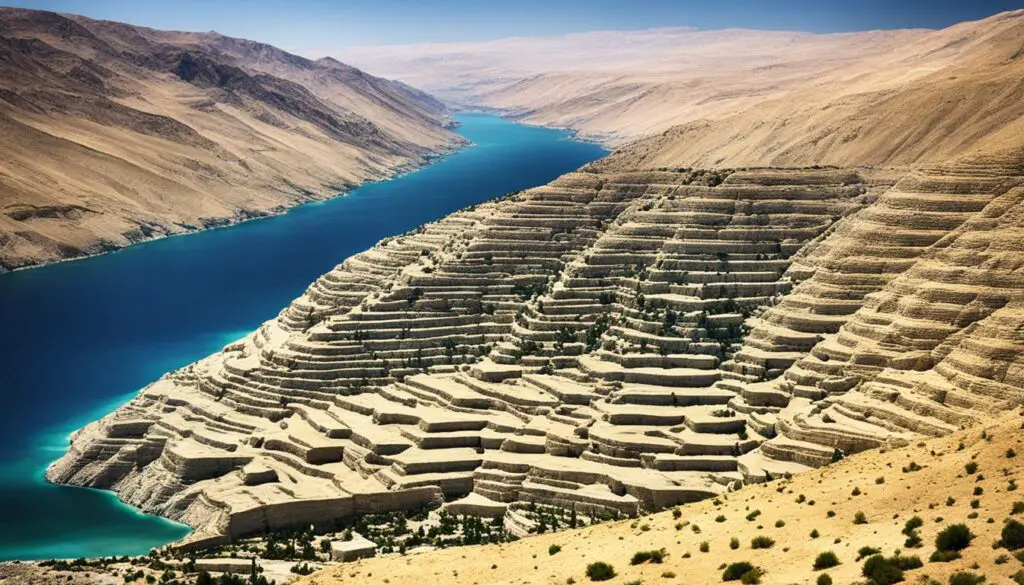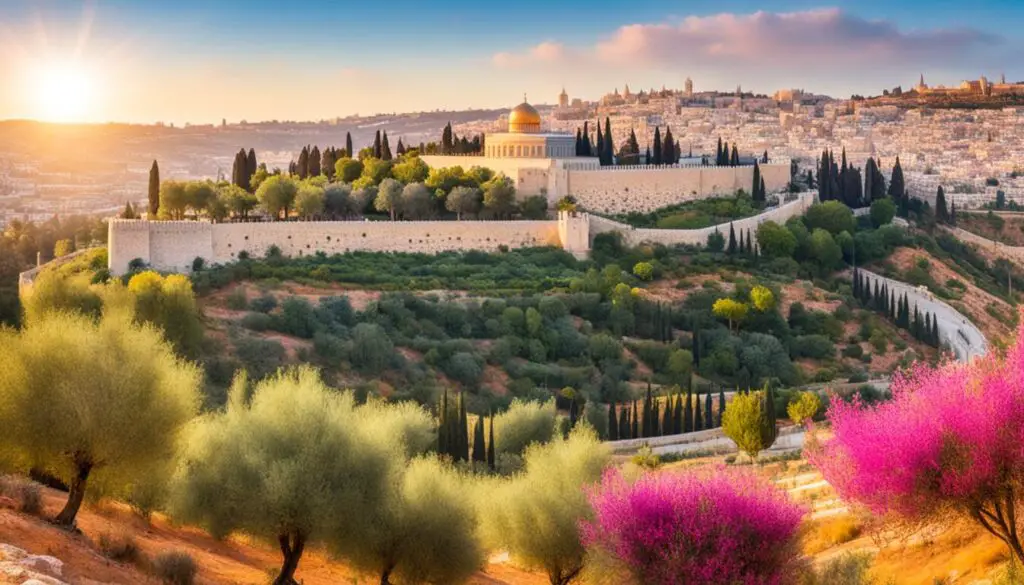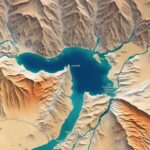The New Testament is a rich source of historical and spiritual wisdom, containing stories and teachings that have shaped the lives of millions of people around the world. This sacred text not only brings us closer to the teachings of Jesus Christ and other biblical figures but also provides valuable insights into the geographical landscape that served as the backdrop for these events.
Key Takeaways:
- The New Testament contains numerous references to significant places, landmarks, and historical sites that are vital to understanding its context.
- Exploring the biblical locations mentioned in the New Testament can deepen our appreciation for the teachings and ministry of Jesus Christ.
- These sacred sites offer a tangible connection to the stories and events that unfolded thousands of years ago.
- By exploring the holy places in the New Testament, we can gain a deeper understanding of the biblical narrative and its impact on our faith.
- Some must-visit places in the New Testament include Bethlehem, Jerusalem, Capernaum, and the Jordan River.
Importance of Geographical Context in Bible Study
The understanding of the New Testament is greatly enhanced by considering the historical and geographical context in which it was written. The inclusion of detailed geographical information serves multiple important purposes in Bible study. By examining the significance of geography in the New Testament, we gain a deeper understanding of the stories and teachings contained within.
The authors of the New Testament were deliberate in their inclusion of geographical details, such as place-names and topographic indicators. These elements were used to ground their narratives in real locations, providing a vivid sense of the physical setting for the events described. The assumption was that their audience was already familiar with these places and could appreciate the significance of their inclusion.
“The inclusion of geographical details in the New Testament not only adds authenticity to the stories but also helps us understand the context in which they took place. It allows us to visualize the physical surroundings and better grasp the cultural, historical, and theological implications.”
By understanding the geographical context, we can better understand the motivations and intentions behind the actions of biblical figures. For example, knowing the physical landscape of the region helps us appreciate why certain events took place in specific locations. The significance of Jesus’ teachings on the Mount of Olives, for instance, can be better understood when we consider its proximity to Jerusalem and its theological significance in Jewish culture.
The geographical details in the New Testament also provide valuable insights into the historical and cultural context of the time. Through the locations mentioned, we can gain a broader understanding of the interactions between different groups and the influence of various empires on the region.
The Importance of Geographical Details:
- Helps situate the narratives in real locations
- Enhances the authenticity of the stories
- Provides theological and historical context
- Aids in visualizing the physical settings
To illustrate the importance of geographical details in Bible study, consider the account of Jesus’ ministry. The choice of Capernaum as a base for his ministry is not arbitrary but rather influenced by its strategic location on the shores of the Sea of Galilee, a major trade route in the region. Understanding this geography helps us comprehend the significance of Jesus’ teachings and miracles that took place in this specific location.
By delving into the biblical geography, we gain a richer understanding of the New Testament. It opens doors to a deeper appreciation of the stories, teachings, and their cultural and historical significance. Exploring the geographical context of the New Testament allows us to immerse ourselves in the world of Jesus and the early Christians, enhancing our connection to their experiences and the message they conveyed.
Importance of Geographical Context in Bible Study
| Benefits | Explanation |
|---|---|
| Enhanced authenticity | The inclusion of geographical details lends credibility to the narratives and reinforces their historical accuracy. |
| Deeper understanding | Geographical context provides insights into the motivations and intentions behind biblical actions and teachings. |
| Cultural and historical perspective | Understanding the geographical context helps us grasp the influence of different empires and cultures during biblical times. |
| Visualization of settings | Geographical details enable us to imagine the physical surroundings and better connect with the stories and teachings. |
Geography of the New Testament: Palestine and Surrounding Regions
The majority of the events in the New Testament take place in the region of Palestine, which encompasses modern-day Israel and its surrounding territories.
This region includes Galilee, Samaria, Perea, Judea, Idumea, and regions northeast of Galilee. Understanding the physical geography of these regions helps us visualize the landscape where the biblical events occurred.
| Region | Description |
|---|---|
| Galilee | A mountainous region in northern Palestine, known for its picturesque landscapes and fertile land. |
| Samaria | A central region in Palestine, characterized by hills and valleys, with the city of Samaria as its capital. |
| Perea | An eastern region of Palestine, situated between the Jordan River and the Dead Sea, known for its rugged terrain. |
| Judea | A southern region in Palestine, including Jerusalem and Bethlehem, with a varied topography of mountains, deserts, and the Dead Sea. |
| Idumea | A region south of Judea, primarily inhabited by descendants of Esau, with rocky hills and arid landscapes. |
| Regions northeast of Galilee | These regions include the Golan Heights and areas bordering modern-day Syria and Lebanon. |
By understanding the physical geography of these regions, we gain insight into the biblical narratives and the context in which they unfold.

Palestine: The Landscapes Mentioned in the New Testament
The New Testament unfolds within the rich and diverse landscapes of Palestine, providing a captivating backdrop for the events and teachings described in the Bible. These landscapes not only serve as physical settings but also carry symbolic and spiritual significance. Let’s explore the four main geographical regions mentioned in the New Testament:
The Central Highlands
The Central Highlands encompass Bethlehem, Nazareth, and Jerusalem, among other significant locations. Bethlehem is renowned as the birthplace of Jesus, while Nazareth holds importance as His childhood home. Jerusalem, situated in the hills, was a central hub for religious and cultural activities. Jesus frequently traveled between the Central Highlands and Jerusalem for various religious observances.
The Jordan Valley
The lush Jordan Valley plays a crucial role in the early ministry of Jesus. It is in this region, particularly around the River Jordan, that Jesus is baptized by John the Baptist. Capernaum, a thriving fishing port located on the shores of the Sea of Galilee, serves as a hub for Jesus’s ministry, and many of His miracles and teachings take place in and around this area.
The Mediterranean Coastal Plain
The Mediterranean Coastal Plain is associated with significant events such as the escape of Mary, Joseph, and Jesus to Egypt to avoid Herod’s wrath. This coastal region also features towns like Tyre and Sidon, which held historical importance during the time of the New Testament. These towns had connections to both Egyptian and Roman influences, shaping the cultural and religious context of the biblical narrative.
The Eastern Plateau
The Eastern Plateau is home to Mount Hermon and the city of Damascus, which played vital roles in the New Testament. The region near Caesarea Philippi, situated on the slopes of Mount Hermon, is where Jesus has profound conversations with His disciples, including Peter’s confession of Jesus being the Messiah. Damascus, an ancient city, is where Paul has a transformative encounter with the risen Jesus, marking a turning point in his life and ministry.
Each of these landscapes within Palestine holds unique geographical features that not only add depth to the biblical narratives but also provide insights into the cultural and historical context of the time. The diverse landscapes of Palestine create a vivid tapestry against which the teachings, miracles, and journeys of Jesus and other biblical figures unfold.

| Landscapes | Main Locations | Significance |
|---|---|---|
| The Central Highlands | Bethlehem, Nazareth, Jerusalem | Birthplace and upbringing of Jesus, central hub for Jewish culture |
| The Jordan Valley | River Jordan, Capernaum | Baptism of Jesus, early ministry base |
| The Mediterranean Coastal Plain | Tyre, Sidon | Escape to Egypt, historical and cultural significance |
| The Eastern Plateau | Mount Hermon, Damascus | Transfiguration of Jesus, Paul’s conversion |
The Central Highlands: Birthplace and Upbringing of Jesus
The Central Highlands, encompassing Bethlehem and Nazareth, hold significant importance in the New Testament as they serve as the birthplace and childhood home of Jesus. Located in the hills of Galilee, Nazareth played a crucial role in the development of Jesus, shaping his upbringing and character. His regular journeys to Jerusalem in the Central Highlands for religious festivals further connect these regions to his life and teachings.
While Bethlehem is primarily recognized as the birthplace of Jesus, Nazareth holds equal significance as the place where Jesus spent his formative years. This humble town provided the backdrop for Jesus’ growth and development, influencing his values, beliefs, and teachings.
“And the child grew and became strong, filled with wisdom. And the favor of God was upon him.” – Luke 2:40
Nazareth’s location in the picturesque hills of Galilee offered Jesus a serene and idyllic environment for his upbringing. Surrounded by beautiful landscapes, Jesus would have been exposed to the wonders of nature, which likely influenced his teachings filled with references to trees, flowers, and birds.
Additionally, the proximity of Nazareth to Jerusalem in the Central Highlands played a significant role in Jesus’ religious and cultural development. Jerusalem was the hub of Jewish religious life and home to the sacred Temple, where Jesus would later engage in profound theological discussions and perform miracles.

The Birth of Jesus in Bethlehem
Bethlehem holds an esteemed place in Christian tradition as the birthplace of Jesus. According to the Gospels of Matthew and Luke, Jesus was born in Bethlehem during the reign of Herod the Great. This small town, located in the southern part of the Central Highlands, is mentioned in the prophecies of the Old Testament, further emphasizing its significance in the birth of the Messiah.
Nazareth: Jesus’ Upbringing
Nazareth, nestled in the hills of Galilee, was where Jesus grew up with his family. As a small agricultural village, Nazareth provided a close-knit community and a humble environment for Jesus’ upbringing. This upbringing in Nazareth would shape Jesus’ understanding of the lives and struggles of ordinary people, influencing his teachings of humility, compassion, and love.
Journeys to Jerusalem
Throughout his life, Jesus made several notable journeys from the Central Highlands to Jerusalem for religious festivals, demonstrating the centrality of Jerusalem in Jewish religious practices. These journeys played a significant role in Jesus’ ministry, as they provided opportunities for spiritual growth, encounters with religious leaders, and the sharing of profound teachings.
Overall, the Central Highlands, with Bethlehem and Nazareth at its core, mark the birthplace and upbringing of Jesus. These regions in the New Testament offer insights into the rich cultural, religious, and natural landscapes that shaped Jesus’ life and teachings, solidifying their enduring significance in Christian tradition.
The Jordan Valley: Baptism and Ministry of Jesus
The Jordan Valley holds great significance in the early ministry of Jesus, as it is associated with his baptism and the establishment of his ministry base. This region, mentioned in the New Testament, plays a crucial role in the unfolding of Jesus’ mission.
John the Baptist challenges people to change their lifestyle in the Jordan Valley.
In the Jordan Valley, Jesus is baptized in the River Jordan, marking a pivotal moment in his life and public ministry. This event signifies his commitment to his divine calling and signals the beginning of his transformative work.
After his baptism, Jesus establishes his ministry base in Capernaum, a thriving fishing port located on the serene shores of the Sea of Galilee. Capernaum becomes the central hub for Jesus’ teaching, healing, and gathering of disciples.
Throughout his ministry in the Jordan Valley, Jesus performs miracles, delivers powerful teachings, and demonstrates his divine authority. He preaches to large crowds, heals the sick, and casts out demons, leaving a profound impact on the people who witness his extraordinary acts.
| Significance of the Jordan Valley in the New Testament |
|---|
|

The Mediterranean Coastal Plain: Escape to Egypt and Roman Encounters
The Mediterranean Coastal Plain played a significant role in the events described in the New Testament. One notable occurrence is the escape of Mary and Joseph to Egypt to protect baby Jesus from the wrath of Herod the Great. This journey to Egypt showcases the geographical and historical importance of the Mediterranean region during biblical times.
The towns of Tyre and Sidon, located on the Mediterranean coast, are also mentioned in the New Testament. These coastal towns were influential hubs with cultural significance, and their mention in the biblical narrative reflects the connections between the Mediterranean and the events of the New Testament.
“And after they had left, behold, an angel of the Lord appeared to Joseph in a dream and said, ‘Rise, take the child and his mother, and flee to Egypt, and remain there until I tell you, for Herod is about to search for the child, to destroy him.’” – Matthew 2:13
The Mediterranean Coastal Plain not only offers historical context to the biblical events but also provides insights into the encounters with the Roman influence. The Roman Empire had a significant presence in the coastal regions, contributing to the cultural and political dynamics during that time.
Immerse yourself in the rich history and cultural significance of the Mediterranean Coastal Plain, where the escape to Egypt and various Roman encounters unfolded in the New Testament.
The Eastern Plateau: Mount Hermon and Damascus
The Eastern Plateau is a significant geographic region mentioned in the New Testament. It serves as the backdrop for pivotal events and encounters that shape the narrative of the Bible. From Jesus’ compelling journey with his disciples to the source of the River Jordan near Caesarea Philippi to Paul’s transformative journey towards Damascus, the Eastern Plateau holds great spiritual and historical significance.

Mount Hermon: A Place of Transfiguration
Mount Hermon is a majestic mountain situated in the Eastern Plateau. It is here that Jesus experiences a transfiguration, a profound moment captured in the New Testament. This event reveals Jesus’ divine nature and confirms his mission as the Messiah. The stunning beauty and spiritual atmosphere surrounding Mount Hermon make it a remarkable location in the biblical narrative.
Damascus: A City of Transformation
“Suddenly a light from heaven flashed around him. He fell to the ground and heard a voice saying to him, ‘Saul, Saul, why are you persecuting me?’” – Acts 9:3-4
The city of Damascus, situated in the Eastern Plateau, plays a pivotal role in the New Testament. It is here that Saul, later known as the Apostle Paul, has a life-changing encounter with the risen Lord Jesus. This encounter leads to his transformation and sets the stage for his significant contributions to the spread of Christianity. Damascus holds a significant place in biblical history and serves as a symbol of redemption and grace.
Table:
| Eastern Plateau Locations | Significance |
|---|---|
| Mount Hermon | Transfiguration of Jesus |
| Damascus | Transformation of Saul to Apostle Paul |
The Eastern Plateau, with its breathtaking landscapes and historical significance, offers a deeper understanding of the biblical narrative. It invites us to reflect on the transformative experiences and the power of encountering God in unexpected places. Exploring Mount Hermon and Damascus allows us to connect with the events that unfolded in these sacred locations, enriching our spiritual journey and strengthening our faith.
Significance of Geographical References in the New Testament
Geographical references in the New Testament serve a theological purpose, connecting the physical locations to spiritual concepts and biblical history. The use of place-names and allusions to Old Testament stories with specific locations helps to reinforce the theological themes and the connection between the teachings of Jesus and the heritage of Israel.
Theological geography in the New Testament allows us to explore the deeper meaning behind the physical landscapes mentioned in the biblical narratives. By understanding the spiritual geography, we can uncover hidden layers of symbolism and significance that enhance our understanding of the teachings and events recorded in the Bible.
“And they said to him, ‘Where, Lord?’ He said to them, ‘Where the corpse is, there the vultures will gather.’” – Luke 17:37
This quote exemplifies the spiritual geography employed in the New Testament. The phrase “where the corpse is, there the vultures will gather” uses the physical image of vultures congregating around a carcass to convey a spiritual message. It suggests that where there is spiritual decay, darkness, or immorality, evil forces will thrive.
Spiritual geography in the New Testament also underscores the importance of place-names in the Bible. Each place has its own historical and cultural significance that enriches the theological narrative.
For example, the city of Jerusalem holds great theological significance as the location of Jesus’ crucifixion and resurrection. The mention of Jerusalem evokes images of sacrifice, redemption, and the establishment of God’s kingdom.
| Location | Significance |
|---|---|
| Bethlehem | Birthplace of Jesus |
| Calvary | Site of Jesus’ crucifixion |
| Mount Sinai | Place where Moses received the Ten Commandments |
The use of place-names in the Bible fosters a sense of connection between the physical world and the spiritual realm, allowing readers to deepen their understanding of the biblical narrative.
By exploring the theological and spiritual significance of geographical references in the New Testament, we can gain a richer understanding of the biblical teachings and the profound connection between physical places and the spiritual truths they represent.
Exploring the Sacred Sites of the New Testament
The New Testament is filled with sacred sites that hold immense historical and spiritual significance. These locations provide a tangible connection to the life and ministry of Jesus Christ and other biblical figures. By visiting these must-visit biblical locations, we can deepen our understanding of the biblical narrative and witness the historical wonders mentioned in the Bible.
One of the most iconic sites in the New Testament is Bethlehem, the birthplace of Jesus. Located in the Central Highlands of Palestine, Bethlehem holds a special place in the hearts of Christians worldwide. Visiting the birthplace of Jesus allows us to reflect on the profound impact his life and teachings have had on humanity.
Journeying to Jerusalem, the City of David, is another must-visit experience for those exploring the sacred sites of the New Testament. Jerusalem is rich in historical and religious significance, with iconic locations such as the Western Wall, the Via Dolorosa, and the Church of the Holy Sepulchre. Walking in the footsteps of Jesus within the walls of Jerusalem is a truly transformative experience.
Capernaum, located on the shores of the Sea of Galilee, is another biblical site of great importance. This town served as a base for Jesus’s ministry, and many significant events, such as the healing of Peter’s mother-in-law and the sermon on the mount, took place here. Exploring the ruins of Capernaum allows us to glimpse into the daily life and teachings of Jesus.
“And Jesus said to him, “Foxes have holes, and birds of the air have nests, but the Son of Man has nowhere to lay his head.””
The Jordan River, where Jesus was baptized by John the Baptist, is a site of immense spiritual significance. Taking a moment to reflect and reenact the baptism of Jesus in the serene waters of the Jordan River can be a deeply personal and meaningful experience.
By visiting these sacred sites in the New Testament, we have the opportunity to immerse ourselves in the rich history and spiritual teachings of the Bible. These locations provide a tangible connection to the events and stories that have shaped the world for centuries.
| Sacred Sites | Location | Significance |
|---|---|---|
| Bethlehem | Central Highlands, Palestine | Birthplace of Jesus |
| Jerusalem | Central Highlands, Palestine | City of David, Crucifixion, Resurrection |
| Capernaum | Galilee, Palestine | Ministry of Jesus, Sermon on the Mount |
| Jordan River | East of Jerusalem | Baptism of Jesus |
Visiting these sacred sites in the New Testament allows us to connect with the historical wonders and spiritual teachings of the Bible. These must-visit biblical locations provide a profound experience that can deepen our faith and understanding of the biblical narrative.
Conclusion
The geographical features mentioned in the New Testament are not mere background settings but have significant importance in understanding the context and depth of the biblical events and teachings. Exploring the physical and metaphysical geography of the New Testament can enrich our understanding of the Bible and enable us to connect more deeply with the ancient world in which these events took place.
By visiting the sacred sites and historical wonders mentioned in the New Testament, we have the opportunity to walk in the footsteps of ancient biblical figures and gain a tangible sense of the places where significant events unfolded. From Bethlehem, the birthplace of Jesus, to Jerusalem, the center of Jewish religious life, each location carries its own unique spiritual and historical significance.
By immersing ourselves in the geographical features of the New Testament, we can glimpse into the world in which biblical stories unfolded and deepen our faith. These places offer us a tangible link to the biblical narrative, allowing us to connect with the past and draw inspiration for our spiritual journey today. Exploring these sacred sites is a powerful way to encounter the living history of the New Testament and cultivate a deeper understanding of our faith.







